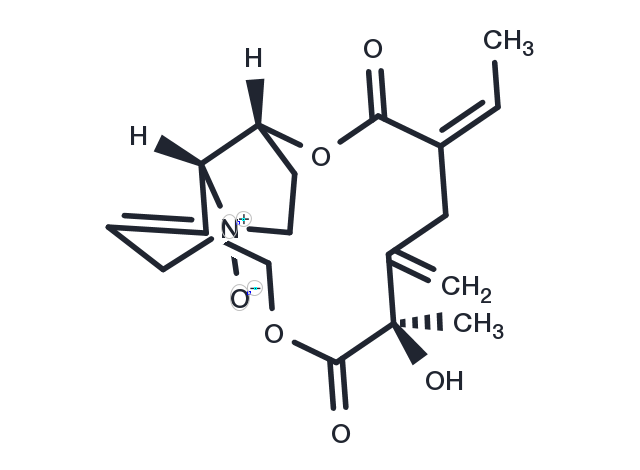store at low temperature,keep away from direct sunlight
Powder: -20°C for 3 years | In solvent: -80°C for 1 year

Seneciphylline N-oxide is a pyrrolizidine alkaloid obtained from Emilia sonchifolia and is the dehydrogenation product of Senecionine N-oxide.

| Pack Size | Availability | Price/USD | Quantity |
|---|---|---|---|
| 5 mg | Inquiry | $ 1,890.00 | |
| 1 mL * 10 mM (in DMSO) | Inquiry | $ 2,289.00 |

| Description | Seneciphylline N-oxide is a pyrrolizidine alkaloid obtained from Emilia sonchifolia and is the dehydrogenation product of Senecionine N-oxide. |
| In vitro | Root cultures of Senecio erucifolius (Asteraceae) efficiently took up and incorporated [14C]putrescine and [14C]arginine into the pyrrolizidine alkaloid (PA) senecionine N-oxide. Pulse-chase experiments covering a growth period of 10 to 19 days revealed the absence of any significant alkaloid turnover[1] |
| In vivo | Seneciphylline was quickly absorbed into plasma (Tmax , 0.23-0.32 h) and reached the maximum concentration of 0.82-1.75 μg/mL after oral administration. Both seneciphylline and seneciphylline N-oxide were eliminated from plasma quickly. The low system exposure (oral bioavailability, 5.43-10.31%) was related to the extensive metabolism in the liver and microflora.[2] |
| Molecular Weight | 349.38 |
| Formula | C18H23NO6 |
| CAS No. | 38710-26-8 |
store at low temperature,keep away from direct sunlight
Powder: -20°C for 3 years | In solvent: -80°C for 1 year
You can also refer to dose conversion for different animals. More
bottom
Please see Inhibitor Handling Instructions for more frequently ask questions. Topics include: how to prepare stock solutions, how to store products, and cautions on cell-based assays & animal experiments, etc.
Seneciphylline N-oxide 38710-26-8 Seneciphylline Noxide Seneciphylline N oxide inhibitor inhibit
